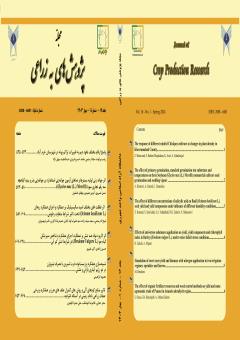Effects of anti-stress substances application on yield, yield components and chlorophyll index in Barley (Hordeum vulgare L.) under water deficit stress conditions
Subject Areas : Crop Production ResearchHossein Zahedi 1 * , Akbar Alipour 2
1 - Department of Agriculture, Eslamshahr Branch, Islamic Azad University, Eslamshahr, Iran
2 - Assistant Professor, Department of Agriculture and Integrated Crops Research Center, Eslamshahr Branch, Islamic Azad University, Eslamshahr, Iran.
Keywords: Chitosan, Chlorophyll, Epibrassinolide, Folic acid, Glutathione, Water deficit, Yield,
Abstract :
In order to investigate the reduction of water deficit stress by using Priming and foliar application of anti-stress materials on the yield and yield components in Barley, an experiment as split plots in RCBD with 3 irrigation regimes and 6 Priming and foliar application in three replication in 2018-19 was implemented. Irrigation regimes include optimal irrigation, moderate and severe irrigation in the main plots and the application of anti-stress substances in the form of seeding and foliar spraying, including chitosan with a concentration of 500 mg/liter, epibrassinolide with a concentration of 1 micromolar, folic acid with a concentration of 50 micromolar and glutathione with The concentration of 150 mg/liter, distilled water and control were randomly placed in sub-plots. The results of the statistical analysis of the data and the comparison of the average traits showed that the effect of the application of anti-stress materials in different irrigation regimes was the same, so that in all the irrigation regimes, chitosan topped the rest of the seeding and foliar treatments in terms of improving the measured traits, and the maximum yield traits and yield components and also obtained the morphological and physiological traits in basil variety. Therefore, the use of anti-stress materials can be fruitful in optimal irrigation and increase most of the desirable traits in the climate of the basil variety.

